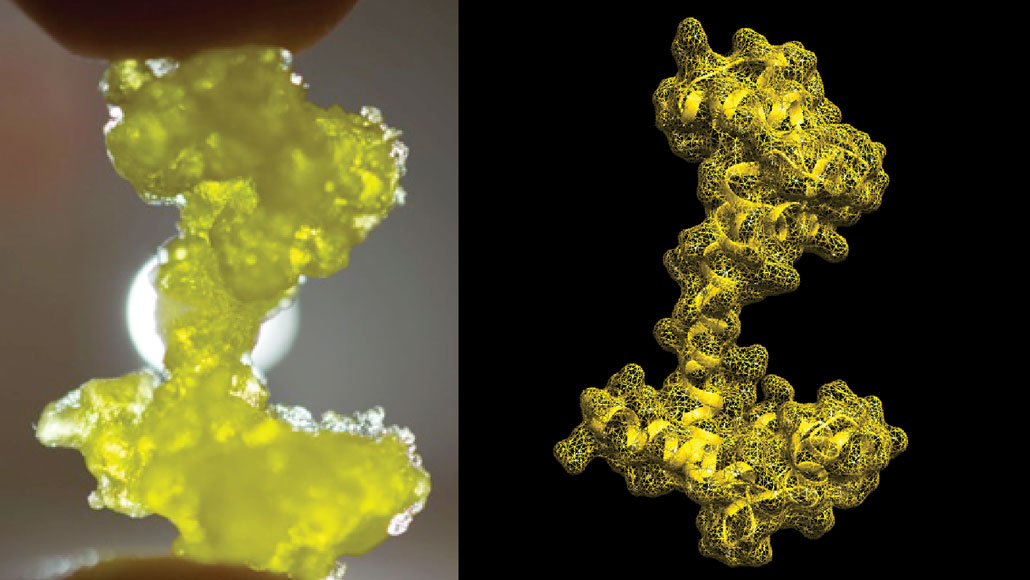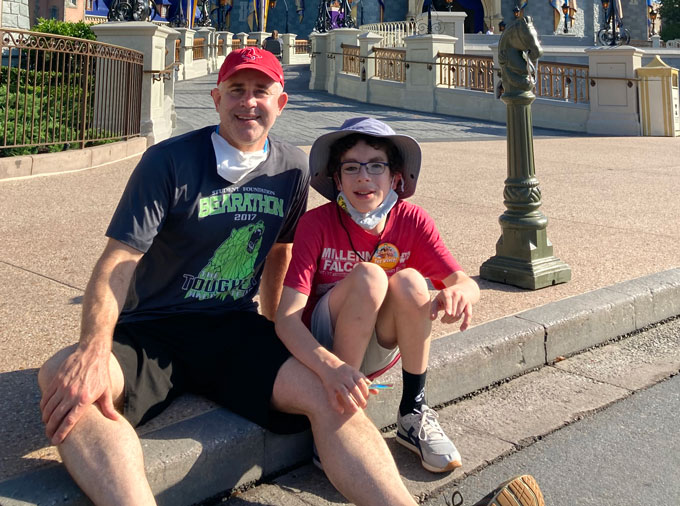Father-son bond inspires sweets that model the shapes of molecules
The bite-sized gummy candies could help even the playing field for students who are blind

Bite-sized replicas of real proteins, such as this gummy model (left) of a calcium-binding protein (computer image, right), could make science more accessible for students who are blind.
Bryan F. Shaw/Baylor University
By Carmen Drahl
Noah Shaw loves planets and has perfect pitch. This 13-year-old also wants to be a scientist, like his father. Bryan Shaw is a biochemist at Baylor University in Waco, Texas. But Noah’s career path may not be as smooth as it was for his dad.
Doctors diagnosed Noah, as an infant, with retinoblastoma. The boy now has only one eye. He also has permanent blind spots in his vision. People with one eye, like Noah, and people who have blindness or limited vision, are underrepresented in science. One reason: They face barriers in their education. Among those barriers, Bryan Shaw notes: “Most of the stunning imagery in science is inaccessible to people who are blind.” That makes him a little sad. Images of proteins are what hooked him on science.
Bryan and his colleagues hope to make science more inclusive. To do that, they have come up a new type of with molecule models. Each one takes advantage of the mouth’s supersensitive touch sensors. Those sensors can perceive finer details than our fingertips can.
The team created models of important proteins such as myoglobin. It provides oxygen to muscles. Like gummy worms and bears, these literally bite-size models are a type of chewable gelatin-based candy. The researchers also 3-D printed nontoxic versions that are not meant to be eaten. Both types can be popped in the mouth where their shapes can be felt.

To prevent choking, the researchers attached lanyards to the nonedible models. After blindfolding 281 college students and 31 grade schoolers, they gave the students edible or nonedible models to inspect.
Each student examined one protein model either by mouth or by hand. For every additional protein model that the students worked with, they had to determine whether the protein was the same as the first or different. A separate group of 84 college students did the test by eyesight using 3-D computer images of those proteins instead of models they could actually feel.
Students correctly identified the proteins about 85 percent of the time, the team reported May 28 in Science Advances. This was true whether they used their mouths, fingers or eyes. Such cheap, tiny models could help students learn about proteins regardless of how well they can see, Bryan Shaw says.
He got the idea for such an educational tool while twirling a blackberry on his tongue. The fruit’s bumpy exterior looks like a popular way that scientists depict proteins, in which each of the protein’s atoms is represented by a sphere. Stick thousands of atoms together, and the clump resembles an elaborate berry — something the tongue might be able to tell apart by shape.
Infants and toddlers typically explore their world at least partially by mouth. A student in Hong Kong made headlines in 2013 by teaching herself to read Braille with her lips. However, the mouth’s remarkable sensing ability remains largely untapped in science education, Shaw says.
He has patented the models and is eager for advice. But taking the models from prototype to teaching tool will require more work. For instance, the researchers have access to professional equipment to print models and sterilize them between uses. That’s not something all educators have.
The models also would benefit from testing by students who are blind and those who have low vision. Their input could help Shaw’s team improve the models to better fit the students’ needs. Shaw has discussed such models with educators at the Texas School for the Blind and Visually Impaired in Austin. Young Noah did test the models. But his dad’s team didn’t include his data in their analysis.
This is not the first time that Noah has inspired his dad. Shaw previously codeveloped an app that has the potential to catch early signs of eye disease in childhood pictures. Regardless of whether Noah finds a career in science, his father has one wish: “I hope he does something cool.”







